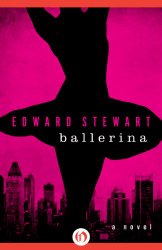You opted to receive this newsletter at DanceAdvantage.net. If you've changed your mind, Opt Out and you won't be contacted again. |
 |
Has Anything Changed? Do You Want It To?
Manage Your Subscription Not a Subscriber? Get more. Get Subscriber PLUS. If you like this article, please share it! Thank you! Turning Pages: Timeless “Ballerina” Guest Contributors | Oct 16, 2014 01:58 am
Stewart, who passed away in 1996, was actually a musician and composer who attended private school as a boy and Harvard as a young man. He edited the famous Lampoon humor magazine for Harvard and then went on to write thrillers. “Ballerina” is neither a comedy nor a thriller. It’s a drama set in New York City in the late 70s, in the world of ballet when Misha was a household name and Balanchine ruled. However, other than a lack of cell phones and text messaging, there is really nothing dated about the novel. As most dancers know, ballet is about the body, about personal relationships, about politics and music and emotions. It is not about technology and because of that, the story remains timeless over thirty years later. The ballerina of the title could be any one of three women, our main characters. There is Anna Lang, who left ballet to have a family years ago but believes she could have been a major star. There is her daughter Stephanie Lang, who has a solid head on her shoulders and is much more kind-hearted than her mother. And finally, there is Christine Avery, Steph’s best friend, a fragile girl who, although a beautiful dancer, is chronically ill and also unsupported emotionally by her rich parents. The story begins with Steph and Chris competing for scholarships to the prestigious NBT school. The two girls are both blonde and slender and even Anna has trouble telling them apart. They become fast friends, which is unusual in this world of highly competitive young women, and neither seems to envy the other. Somehow Steph manages to stay sane while Anna pushes her harder and harder toward their shared goal of Steph getting into NBT’s company. The girls are roommates, first living with Anna and later on their own, and hard-working. When it’s time for company contracts, however, the girls must separate, although they continue to live together. Steph is chosen for Empire and Chris for NBT. You could think of these companies as ABT and NYCB: both are exceptional companies but only one has Balanchine as its artistic director. And this is where things start to get dramatic. Anna is convinced Steph was overlooked by NBT’s Marius Volmar who was the director when she was a young dancer and who kicked her and her husband Marty out of the company years ago just on the cusp of them becoming principals. Anna is a tough chick, what they probably would have called a “broad” back in the mid-50s, who is no-nonsense and rough-edged. She might not have a formal education or a lot of money but she has a lot of guts. She does have her soft spots, though, as is evidenced when she takes in Chris, whose parents practically disown her when she joins the company. Both girls rise through the ranks of each company and there is, naturally, lots of overlap and competition but they support each other throughout it all in an unusually generous spirit. There are the obligatory crushes on gay men, the cruel looks from jealous company members, the anguish of losing roles, the men who love them from afar. But fortunately this book avoids many clichés we’ve come to expect: the girls never truly become backstabbing enemies; there are no drug or alcohol addictions; no eating disorders to maintain an impossibly thin line; no pregnancies or horrible injuries that ruin careers. Love is the one thing the girls do fight over – love in the form of Sasha Bunin, a defector from Russia who is a stand-in for Baryshnikov. But unlike the other famous Russian dancer, Sasha is not a known quantity; he is no more than a soloist when he comes to the US and he is not embraced as an immediate savior of the dance world. After all, there is already Baryshnikov in this fictional world. So Sasha must prove himself to be exceptional, as well as exceptionally handsome. Falling in love with Sasha is what propels Chris toward her downward spiral. She is naïve and virginal and doesn’t see that Sasha is a ladies’ man and that he loves himself more than any woman. Steph sees through that but still finds herself falling for him. As Chris gets sicker and sicker, and thinner and thinner, Steph tries very hard to keep her healthy and sane but eventually loses her temper. Their friendship is definitely threatened by Sasha and severely tested to its breaking point. Is all well in the end? Does everything end happily? No, thank goodness. The culmination of the novel is a premiere of “Sleeping Beauty” by NBT. It is the restored version of Petipa’s original choreography, with a dance for Aurora that had been cut decades earlier and never seen again on stage. The stars of the show were to be Steph and Wally but, as circumstances and drama dictate, they are not the ones to dance the leads that night. In one case, a career is made while in another a career ends. The book sprawls across 500+ pages and includes lots and lots of very detailed dance terminology, discussion of ballet company politics, and description of dance history. Names like Gelsey Kirkland and Maria Tallchief and Rudy and Misha are dropped all over the place. Readers who grew up in the 70s or who studied dance history will be delighted to recognize some of their favorite stars (and will wonder if Edward Stewart embellished the anecdotes he tells). Personally, I was tickled to see Colleen Neary’s name in print; she is currently the artistic director of Los Angeles Ballet with her husband and had been a dancer with Balanchine back in the 70s. Also, as an instructor and dancer, I was thrilled to read accurate terminology being used instead of general descriptions being tossed about. True, for the non-dancer, the French phrases might be confusing but Stewart does an excellent job of placing them all in context or defining them as necessary, and a modified glossary is included in the back of the book. “Ballerina” was fast-paced and an easy weekend read – and far better written than I expected. And once I picked it up, I didn’t want to put it back down.
Leave a comment on this post Have You Missed These? The Five Freshest at DA Miko Fogarty: Her Flare for Flan and Dramatic Style How To Improvise Movement When You’ve Never Done It Before Individual Goals for Individual Dancers Got Curves? Leotards and Skirts That Flatter Interview with Kathryn Morgan |

|
If you like being a DA insider but feel like the blog updates are too much. Here's what you can do:
1. Update your profile and choose "Send me blog updates... NEVER" 2. Then, read the latest posts via RSS feed instead, while still enjoying the PLUS! Learn more about RSS here: How to Create Your Own Dance "Magazine" Unsubscribe <<Email Address>> from this list. Copyright (C) 2009 Dance Advantage All rights reserved. Manage Your Subscription
You are receiving this email because you opted in at http://danceadvantage.net
Dance Advantage 530 Trail Springs Ct Kingwood, TX 77339 USA |


 Leigh Purtill is a ballet instructor, choreographer and coach in Los Angeles where she lives with her husband and dog. She received her master’s degree in Film Production from Boston University and her bachelor’s in Anthropology and Dance from Mount Holyoke College. She has published two novels with Penguin’s Razorbill imprint. She currently teaches all levels of ballet to teens and adults in LA and Pasadena. Zombie ballet is her passion. She can be reached through her blog:
Leigh Purtill is a ballet instructor, choreographer and coach in Los Angeles where she lives with her husband and dog. She received her master’s degree in Film Production from Boston University and her bachelor’s in Anthropology and Dance from Mount Holyoke College. She has published two novels with Penguin’s Razorbill imprint. She currently teaches all levels of ballet to teens and adults in LA and Pasadena. Zombie ballet is her passion. She can be reached through her blog: